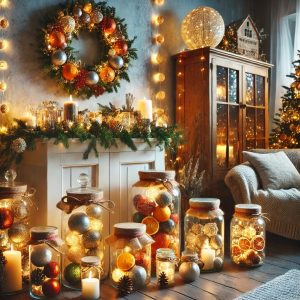The holiday season brings with it an infectious spirit of joy, love, and togetherness. While many associate the season with traditions like Christmas trees, gift-giving, and festive meals, these customs can look quite different depending on where you are in the world. Each culture has its own way of celebrating, reflecting unique histories, values, and beliefs that make the holiday season even more meaningful. In Germany, for instance, Christmas markets are a beloved tradition, where people gather to sip mulled wine, sample gingerbread cookies, and shop for handcrafted ornaments. Meanwhile, in Mexico, Las Posadas, a nine-night celebration, reenacts Mary and Joseph’s search for shelter, culminating in a joyful feast and the breaking of a piñata. In the Philippines, the holiday season kicks off with a “Simbang Gabi,” a nine-day series of dawn masses leading up to Christmas Eve, followed by a grand feast. In India, Diwali, the festival of lights, brings families together to decorate their homes with oil lamps, exchange sweets, and celebrate the triumph of light over darkness. Meanwhile, in Japan, where Christmas isn’t widely observed as a religious holiday, couples enjoy romantic dinners, and people line up for the popular Christmas cake, a symbol of celebration. Across the globe, these festive traditions offer a beautiful mosaic of cultural practices that highlight the universal desire for love, family, and community, reminding us all that the holiday spirit transcends borders, bringing people together in shared joy.
Holiday Sparkle on a Shoestring: Budget-Friendly Decor Hacks
The holiday season is all about creating warmth, joy, and sparkle in our homes—but that doesn’t mean you have to spend a fortune on decor. With a little creativity and a touch of DIY magic, you can transform your space into a festive wonderland on a budget. Start by reimagining what you already have. Those glass jars gathering dust in your pantry? Fill them with twinkling string lights, pinecones, or ornaments for an instant centerpiece. Take a walk outside and gather natural elements like branches, holly, or evergreen sprigs, then display them in vases or weave them into a wreath. A simple strand of fairy lights can work wonders, turning any room into a cozy retreat, especially when paired with handmade paper snowflakes or garlands made from popcorn and cranberries. Don’t overlook the power of repurposing old holiday cards as cheerful wall art or gift wrap. Even scraps of wrapping paper or fabric can be cut into festive shapes and used as table accents or ornaments. The trick to budget-friendly holiday decor is seeing the potential in everyday items and adding your personal flair. It’s not about how much you spend, but the love and creativity you pour into your space. The result? A home that sparkles with holiday cheer, reminding you that the best decorations are those that come from the heart.
Jingle and Mingle: Crafting the Ultimate Holiday Party
The holiday season is the perfect time to gather your loved ones, friends, and neighbors for a celebration filled with laughter, joy, and festive cheer. Crafting the ultimate holiday party doesn’t have to be overwhelming—it’s all about creating an inviting atmosphere, offering delicious food and drinks, and adding personal touches that make the night unforgettable. Start with the ambiance: twinkling lights, candles, and a carefully curated playlist of holiday classics will set the mood. For decorations, mix traditional elements like wreaths and garlands with creative DIY pieces, such as mason jar snow globes or hand-painted ornaments, to add a unique charm.
When it comes to food, a mix of crowd-pleasers and festive treats is key. A hot cocoa bar with toppings like whipped cream, marshmallows, and peppermint sticks can be a hit, while bite-sized appetizers and a charcuterie board ensure there’s something for everyone. For dessert, themed cookies or a holiday cake can steal the show. To make the night interactive, include fun activities like a gingerbread house competition, a secret gift exchange, or karaoke featuring everyone’s favorite holiday songs.
The heart of any holiday party lies in the connections it fosters. Whether it’s old friends catching up or new acquaintances sharing a laugh, the moments of togetherness are what make the event truly magical. With a little planning and a lot of love, your holiday party can become a cherished tradition that leaves everyone counting down to next year’s gathering.
Holiday Treats with a Twist: Romantic Cooking Adventures for Couples
The holidays are a time for indulgence, celebration, and love, making it the perfect season to bond with your partner in the kitchen. Cooking together isn’t just about creating delicious treats—it’s a romantic adventure where you can share laughs, spark creativity, and make lasting memories. Instead of sticking to the usual cookie-cutter recipes, why not add a twist to your holiday treats? Try crafting hot cocoa bombs with unique flavors like salted caramel or peppermint mocha, turning a simple drink into a delightful surprise. Bake cookies together, but give them a playful spin by decorating them as characters from your favorite holiday movies. For something more savory, experiment with mini quiches or holiday-themed flatbreads topped with festive ingredients like cranberries, brie, and sprigs of rosemary.
The beauty of cooking as a couple is in the shared experience. One of you can roll dough while the other measures ingredients, or you can team up to taste-test along the way—because quality control is essential, right? Don’t forget to set the mood with soft holiday music and perhaps a glass of mulled wine or champagne to toast your creations. Cooking together fosters communication, teamwork, and plenty of flirtatious fun, transforming a simple activity into an intimate and meaningful holiday tradition. By the end of the evening, you’ll not only have treats to enjoy but also a kitchen filled with laughter and love.
A Festive Wonderland: Exploring Christmas Markets Around the World
The holiday season is a time for magic, and few experiences capture this enchantment like visiting Christmas markets around the world. These festive bazaars, adorned with twinkling lights, charming stalls, and the sweet scent of seasonal treats, transport you into a wonderland filled with holiday cheer. From the cobblestone streets of Europe to the bustling city squares of Asia, each market offers a unique way to celebrate the season.
In Germany, the Christmas markets, or “Weihnachtsmärkte,” are a centuries-old tradition. Cities like Nuremberg and Munich transform into winter havens, with their iconic wooden stalls selling everything from handcrafted ornaments to delicious bratwurst and mulled wine. The markets are a feast for the senses, with carolers filling the air with joyful tunes and the smell of roasted chestnuts tempting passersby.
Heading to France, the Alsace region offers some of the most picturesque markets, especially in Strasbourg, which is known as the “Capital of Christmas.” The streets are lined with medieval half-timbered houses adorned in festive décor, and the market offers a perfect mix of local crafts, artisanal foods, and holiday spirit. Meanwhile, in the United Kingdom, the Christmas markets in cities like London and Edinburgh combine British charm with festive cheer, offering everything from traditional Victorian carolers to classic holiday treats like mince pies and hot cider.
Even further afield, in Japan, the Christmas markets in Tokyo have a distinctly European flair, blending holiday traditions with a unique Japanese twist. Here, you’ll find beautifully crafted ornaments, German sausages, and even unique items like “sakura” flavored treats—combining the best of both worlds.
Whether you’re searching for one-of-a-kind gifts, savoring seasonal snacks, or simply soaking in the magical atmosphere, visiting a Christmas market is an unforgettable way to celebrate the season and create lasting memories. Each market offers a glimpse into a different culture’s holiday traditions, while uniting us all in the spirit of joy, goodwill, and togetherness.
Snowy Getaways: Exploring the Most Romantic Winter Destinations
There’s something undeniably magical about winter—the soft blanket of snow, crisp air, and twinkling lights set the stage for romance like no other season. For couples looking to escape the everyday and reconnect, snowy getaways offer the perfect blend of adventure and intimacy. Whether you’re drawn to cozy cabins or luxury resorts, the world is full of winter destinations that will make your hearts melt.
Imagine strolling hand in hand through the enchanting streets of Hallstatt, Austria, where charming alpine houses sit along a serene, snow-dusted lake. Or perhaps you’d prefer a getaway to Banff, Canada, where the stunning Rockies provide the backdrop for sleigh rides, ice skating, and evenings by the fire. For something a little closer to home, Vermont’s quaint towns deliver that hallmark winter charm with tree-lined streets, artisanal treats, and plenty of opportunities to ski or snowboard.
If you’re craving a unique experience, take a trip to Finland’s glass igloos in Saariselkä. There, you can watch the northern lights dance across the sky from the warmth of your bed—a memory you’ll cherish forever. And for those who love combining luxury with tradition, Switzerland’s St. Moritz offers glamorous hotels, world-class dining, and picturesque mountain views. Wherever you choose to go, these snowy escapes promise moments of togetherness that feel straight out of a fairytale.
Romantic winter getaways aren’t just about the destination—they’re about the shared experiences that make your bond even stronger. From sipping hot cocoa in a rustic lodge to exploring frozen landscapes together, every moment is a reminder of the beauty of love and the magic of winter.
From Red-Nosed Reindeer to Hot Cocoa: A Guide to Christmas Date Ideas
The Christmas season is full of charm and magic, making it the perfect time for cozy and romantic date ideas. Whether you’re looking to embrace holiday traditions or create your own memorable moments, Christmas offers a wealth of unique experiences to share with your special someone. Imagine snuggling up on a crisp evening, sipping hot cocoa by the fire, or exploring festive light displays—each moment feels like something out of a holiday movie.
Start with a classic Christmas tradition—ice skating under the twinkling lights. Whether you’re gliding hand-in-hand on a local rink or taking a scenic spin around an outdoor rink in a beautiful winter wonderland, this activity brings out the festive spirit and is perfect for sharing laughs and cozy moments. Afterward, you can retreat to a nearby café for hot cocoa or a warm spiced cider, keeping the warmth of the evening alive.
Another fun and unique date idea is to attend a holiday light show or take a stroll through a Christmas market. There’s something magical about walking through an enchanting display of lights while holding hands, surrounded by the scent of seasonal treats and the sounds of festive music. You can shop for homemade gifts, sip on mulled wine, or simply enjoy the cozy atmosphere together.
If you’re in the mood for something a little quieter and intimate, consider having a holiday movie marathon. Create a cozy space with blankets, pillows, and holiday-themed snacks, and settle in to watch your favorite Christmas classics or new festive films. For a fun twist, you can make a game out of spotting holiday clichés or create your own themed holiday cocktails.
No matter what you choose to do, the key is to embrace the spirit of the season and make the most of the time spent with each other. Christmas is all about warmth, love, and togetherness, and these festive date ideas are the perfect way to bring those feelings to life.
The Naughty or Nice Guide to Gifting: Spark Creative Magic for Your Partner
The holiday season is the perfect opportunity to surprise your partner with a gift that shows just how well you know them—and how much you care. However, finding the balance between sweet, thoughtful gestures and a bit of cheeky fun can elevate your gifting game from ordinary to extraordinary. The key lies in blending creativity and personalization, ensuring that every present feels meaningful while also adding an element of playful excitement. Whether you lean into the “nice” side of things or decide to add a little naughty flair, there’s always room for creativity.
For a “nice” gift, think about what truly brings joy to your partner’s life. Perhaps it’s a cozy sweater from their favorite brand, a set of luxurious skincare products, or a hand-crafted piece of jewelry that holds sentimental value. The nice gifts are thoughtful, sentimental, and chosen with care, ensuring your partner feels appreciated and loved.
On the “naughty” side, a bit of fun and flirtation can make things even more exciting. Consider gifts that encourage playful interaction, like a custom advent calendar filled with surprises, a couple’s board game that leads to cozy evenings together, or perhaps some playful lingerie. These gifts add a layer of fun and spice to the holiday season, bringing you both closer together in both laughter and affection.
The best part of holiday gifting for your partner is that there are no hard rules—it’s all about capturing the essence of your relationship and what will spark joy. Whether you’re creating intimate moments with a “nice” gesture or adding a touch of naughty fun, a well-chosen gift has the power to strengthen your bond and make the season unforgettable. After all, it’s the thought—and a little creativity—that counts the most!
Cozy Nights In: Crafting the Perfect Holiday Ambiance for Two
There’s something incredibly special about spending a quiet evening at home during the holiday season. The rush of shopping, the chaos of last-minute plans—everything fades away when you create a cozy atmosphere for two. Whether you’re snuggled up on the couch or enjoying a dinner by candlelight, crafting the perfect holiday ambiance is all about comfort, warmth, and intimacy. It’s about embracing the spirit of togetherness while creating a space that feels just right for you and your partner.
Start by setting the mood with lighting. Soft, warm lights are essential for creating a cozy feel, and candles—scented or simple—add a touch of romance and magic. Think of the glow of a flickering flame, casting shadows on the walls as you settle in for the evening. String lights or fairy lights, draped over mantels or around windows, can also enhance the festive feel, bringing a touch of holiday wonder into your space.
Next, consider the environment. A pile of plush blankets, a few pillows, and maybe even a cozy rug on the floor can instantly turn any space into a haven of relaxation. Add some holiday touches like a few evergreen branches, a garland of dried oranges, or an elegant centerpiece to bring in a festive spirit without overwhelming the room.
For an extra touch, make the night all about your favorite holiday traditions. Watch a beloved Christmas movie, share your favorite holiday treats, or enjoy a quiet conversation by the fire. A cup of hot cocoa or spiced wine can be the perfect pairing as you chat, laugh, or just enjoy the warmth of each other’s company. The beauty of a cozy night in lies in the simplicity—when you create an intimate, personalized space, it becomes the perfect backdrop for making memories together.
Under the Mistletoe: The Magic of Holiday Kisses
There’s something undeniably enchanting about the tradition of kissing under the mistletoe during the holiday season. Whether it’s a spontaneous moment or part of a playful holiday tradition, the simple act of sharing a kiss beneath the mistletoe holds a special kind of magic that feels timeless. This tradition, full of warmth and joy, adds a layer of intimacy and fun to the festive season. As winter nights grow colder and the holiday lights twinkle all around, there’s no better time to embrace the closeness and affection that this custom brings.
The magic of a holiday kiss lies not just in the moment itself, but in the emotions it evokes. There’s a sense of anticipation in finding the perfect moment to stand beneath the mistletoe together. The sweet excitement of the season, the soft glow of twinkling lights, and the festive cheer in the air all contribute to creating a perfect setting for a kiss. It’s not just about the kiss; it’s about the connection it represents—the bond you share with your partner, the joy of being together, and the warmth that surrounds you during this special time of year.
But the fun doesn’t stop with the mistletoe. Embrace the spirit of romance by making holiday kisses a part of your daily routine during the season. Steal a kiss while wrapping presents, while baking gingerbread cookies, or as you sip hot cocoa by the fire. These small, sweet moments can turn into cherished memories that remind you of the affection and love you share. It’s the little things—the unexpected kisses, the shared smiles, the quiet moments—that make the holiday season so special and filled with love.
Under the mistletoe, or anywhere else, a holiday kiss carries a certain magic that can bring you closer, making your celebrations even more memorable.
A Season for Love: How to Spice Up Your Holiday Date Nights
The holiday season is a magical time for couples, with the crisp winter air, the warmth of the fireplace, and the festive lights setting the perfect backdrop for romance. While the holidays can often be filled with family gatherings and holiday shopping, it’s also an ideal opportunity to connect with your partner in unique and meaningful ways. Spicing up your holiday date nights doesn’t require extravagant plans; sometimes, it’s the small, thoughtful touches that make the biggest impact.
Start by tapping into the holiday spirit and think about what makes this season special. For a cozy date night, create an intimate atmosphere at home. Light candles, hang some fairy lights, and snuggle up with a blanket for a Christmas movie marathon. Don’t forget the seasonal treats like gingerbread cookies or a steaming cup of mulled wine. These simple but effective ideas set a romantic tone and make the evening feel extra special.
For something a little more adventurous, consider outdoor activities like ice skating, strolling through holiday markets, or taking a drive to see the best Christmas lights in town. These activities not only allow you to enjoy the beauty of the season but also give you the chance to make memories together. Afterward, warm up with some hot cocoa at a local café, or head back home for a cozy, quiet evening.
If you’re feeling creative, why not cook a festive meal together? Preparing a holiday dish as a team can be a fun, bonding experience that brings out your playful side. Whether it’s making gingerbread houses or preparing a fancy dinner, cooking together offers a wonderful opportunity to share in the joy of creating something special.
The holiday season is about connection, and by adding thoughtful and fun twists to your date nights, you can make it an unforgettable time of love and laughter.
Red Carpet Christmas: A Guide to Festive Elegance
This holiday season, why not embrace the glamour and sophistication of a red carpet experience? There’s something undeniably elegant about stepping into the Christmas season with a sense of grandeur. From dazzling decorations to luxurious outfits, creating a festive atmosphere that feels like an exclusive event is a beautiful way to celebrate the holidays. Imagine your home aglow with shimmering lights, tables set with fine china, and the air filled with a sense of refined celebration. This is the essence of a red carpet Christmas—a holiday gathering that exudes elegance and leaves a lasting impression.
Start by transforming your space into a winter wonderland with sophisticated decorations. Think gold and silver tones, crystal accents, and rich velvet ribbons. A sparkling tree adorned with elegant ornaments, paired with scented candles and lush garlands, can elevate the ambiance of your home. It’s all about creating an atmosphere that feels luxurious yet warm, with every detail designed to make guests feel like they’re part of something special. You can even design a red carpet entrance for your guests to walk down as they arrive, setting the tone for a night of class and cheer.
For the ultimate festive elegance, pay attention to the little touches. Serve champagne in crystal flutes, set a beautiful dinner table with sparkling glassware, and offer gourmet appetizers that make everyone feel like they’re at an exclusive holiday gala. As the evening unfolds, create a playlist of sophisticated holiday music—think jazzy renditions of classic Christmas carols or instrumental tunes that allow the conversation to flow smoothly.
Fashion is another key element in bringing a red carpet Christmas to life. Encourage your guests to dress in their finest holiday attire, whether it’s black-tie or formal cocktail wear. A little sparkle in the form of sequined dresses or metallic ties can add a touch of festive flair, making everyone feel like stars of the night.
A red carpet Christmas isn’t just about appearances; it’s about creating an unforgettable holiday experience where every detail contributes to a sense of festivity, elegance, and joy. It’s the perfect way to elevate the season and make this Christmas a celebration worthy of the silver screen.
Enchanted Escapades in a Snow-Capped Paradise: A Dreamlike Guide to Secluded Romantic Getaways During Winter
There’s something undeniably magical about winter getaways—especially when you venture into a snow-capped paradise far from the hustle and bustle of everyday life. Picture this: snowflakes gently falling, the world quiet and still, as you and your partner escape to a secluded retreat where time seems to slow down. Winter, with its crisp air and serene landscapes, creates the perfect backdrop for romance and adventure. A secluded romantic getaway in a winter wonderland isn’t just a trip; it’s an experience that allows you and your partner to rediscover each other and the beauty of the season.
Start your journey by choosing a destination that offers both tranquility and adventure. Think of cozy cabins tucked away in the mountains, luxurious lodges nestled beside frozen lakes, or charming chalets surrounded by snow-covered forests. These secluded spots offer privacy, the perfect amount of space for intimate moments, and easy access to winter activities. Spend your days skiing or snowboarding, snowshoeing through pristine trails, or taking romantic walks hand-in-hand through snow-covered streets lit by twinkling holiday lights.
When the temperature drops and the night sets in, retreat to your cozy hideaway for a warm, intimate evening. Imagine curling up by a crackling fire with a glass of wine, savoring the comforting smells of hearty winter meals, or even indulging in a spa treatment. Some of the best memories are made in front of a roaring fire, wrapped in blankets, with your favorite book or just each other’s company. Whether it’s a winter sunset, a night of stargazing, or simply watching the snow fall from the comfort of your cabin, there’s no shortage of magical moments waiting to be made.
Secluded romantic getaways in winter offer the perfect mix of serenity and intimacy. When the world outside is dusted in snow, the feeling of isolation can be transformed into an experience of reconnection, both with nature and with your partner. Whether it’s the adventure of exploring new winter landscapes or the quiet joy of simply being together in a peaceful, snow-filled world, these magical retreats are a dream come true for couples seeking something special this winter season.
The EQ Edge: Unlocking Career Success Through Emotional Intelligence
In today’s fast-paced and ever-evolving professional landscape, technical skills and expertise are undoubtedly important, but there is one trait that can make all the difference in achieving long-term career success: emotional intelligence (EQ). Emotional intelligence refers to the ability to recognize, understand, and manage our own emotions, as well as the emotions of others. This powerful skill can enhance communication, collaboration, and conflict resolution in the workplace, ultimately leading to more effective leadership and stronger team dynamics. While IQ may get you in the door, it’s EQ that often propels you forward and sets you apart from the competition.
One of the key benefits of emotional intelligence in the workplace is improved communication. People with high EQ tend to be better at expressing themselves in a way that resonates with others, whether they’re explaining a new idea to a colleague or providing feedback to a team member. They are adept at tuning into the emotions of others, allowing them to respond with empathy and clarity, which fosters better relationships and more productive conversations. This skill also helps to prevent misunderstandings, as individuals with high EQ can more effectively interpret non-verbal cues and adjust their communication style accordingly.
Another major advantage of emotional intelligence in career success is its impact on leadership. Leaders who exhibit emotional intelligence can create a positive, supportive work environment that motivates their team and fosters trust. They are more likely to inspire loyalty and commitment from their employees because they understand how to manage their own emotions and respond appropriately to the needs and feelings of others. This kind of leadership builds resilience within teams, enabling them to face challenges with confidence and a sense of unity. High EQ also aids in conflict resolution, as it allows leaders to approach disagreements with understanding and a calm demeanor, rather than reacting impulsively or emotionally.
In addition to enhancing interpersonal dynamics, emotional intelligence can significantly improve decision-making. When faced with complex situations, individuals with high EQ are better equipped to manage their emotions and avoid impulsive decisions that could be driven by stress, frustration, or excitement. Instead, they approach challenges thoughtfully and with a clear perspective, considering the feelings and perspectives of others along the way. This balanced approach often leads to smarter, more thoughtful decisions that benefit both the individual and the organization.
Ultimately, emotional intelligence is a crucial tool for achieving career success. It strengthens relationships, fosters positive work environments, and empowers individuals to make thoughtful, effective decisions. While it may not be something that can be easily measured or quantified, the benefits of high EQ are undeniable. By investing in emotional intelligence development, individuals can unlock their true potential and take their careers to new heights.
Crafting Memories: Fun Activities to Bring Families Closer
In the hustle and bustle of everyday life, it’s easy for families to get caught up in their individual routines, often leaving little time for meaningful bonding. However, creating lasting memories and strengthening family ties doesn’t require extravagant vacations or expensive gifts. Simple, fun activities can be the key to bringing families closer together, fostering a sense of connection, and creating cherished memories that will last a lifetime. From cooking meals together to embarking on outdoor adventures, these activities provide the perfect opportunities for families to laugh, learn, and grow together.
One of the best ways to bring families closer is by sharing quality time around the dinner table. Cooking together not only teaches valuable life skills but also fosters teamwork and communication. Whether it’s baking cookies, making homemade pizza, or preparing a multi-course meal, the kitchen becomes a space for creativity and collaboration. Each person can contribute in their own way, making the process feel like a team effort. The joy of sitting down to a meal that everyone had a hand in creating adds an extra layer of satisfaction and strengthens the bond between family members.
For families looking to enjoy some fresh air, outdoor adventures are a fantastic way to build connections. Whether it’s hiking through a nearby forest, playing a game of frisbee in the park, or simply taking a walk through the neighborhood, outdoor activities provide opportunities for families to unplug and enjoy each other’s company. These outings allow families to engage in lighthearted conversations, laugh at each other’s antics, and take in the beauty of nature together. There’s something about being outside, away from screens and distractions, that naturally fosters a sense of unity and relaxation.
For those rainy days or cozy nights in, crafting projects can be a fun and creative way to spend time as a family. Whether it’s making holiday decorations, painting pottery, or building a birdhouse, working on a project together allows everyone to tap into their artistic side and contribute to something meaningful. The sense of accomplishment that comes from completing a project as a team is rewarding, and the resulting creations often serve as reminders of the time spent together.
Board games and puzzles are another excellent way for families to bond. With a little friendly competition, these activities encourage collaboration, problem-solving, and strategic thinking. Plus, they’re a great excuse to unplug from electronic devices and spend quality time face-to-face. Whether it’s an intense round of Monopoly, a game of charades, or working together to complete a challenging jigsaw puzzle, these games offer a chance for families to share laughter and build memories in an enjoyable, low-pressure setting.
Lastly, family movie nights or storytelling sessions can create moments of relaxation and shared experience. Snuggling up with a good movie or taking turns telling stories allows everyone to unwind together and strengthen their emotional connection. For added fun, families can turn these moments into themed nights, complete with homemade snacks, decorations, and costumes. These simple yet meaningful traditions add an extra layer of fun to the time spent together.
In the end, it’s not the grand gestures that create lasting memories—it’s the small, everyday activities that allow families to connect, share, and grow. By making time for fun, creative, and enjoyable activities, families can craft memories that will keep them united for years to come.
Remembering Pearl Harbor: A Day That Lives in Memory
On December 7, 1941, the United States was forever changed when a surprise attack on Pearl Harbor in Hawaii led the nation into World War II. The day, etched in history, left an indelible mark on the lives of those who witnessed it and the generations that followed. For those who lived through it, the events of that day were not just a historical moment—they were personal. Families lost fathers, brothers, and sons; communities grieved the sudden, tragic loss of so many young men who had answered the call to serve. Today, Pearl Harbor stands as a symbol of resilience, sacrifice, and the indomitable spirit of a nation united in the face of adversity.
The attack on Pearl Harbor was a stark reminder of the fragility of peace and the importance of vigilance. In the span of just two hours, Japanese forces launched a devastating strike, bombing military installations and sinking battleships in the harbor. Over 2,400 Americans lost their lives that day, and many others were wounded. The attacks brought the U.S. into the global conflict of World War II, reshaping the course of history and redefining what it meant to fight for freedom. It was a turning point that showed the world the resilience of the American people, who, despite such a devastating blow, would rise to the challenge and play a pivotal role in the eventual defeat of the Axis powers.
Today, Pearl Harbor serves as both a solemn memorial and a source of inspiration. Every year, survivors and their families gather to remember the fallen and honor the bravery of those who fought to protect their country. The Pearl Harbor National Memorial stands as a tribute to the sacrifice made by so many, offering visitors a chance to reflect on the heroism of those who endured the horrors of that fateful day. The attack may have marked the beginning of the United States’ involvement in World War II, but it also marked the beginning of a legacy of perseverance and courage.
As we remember Pearl Harbor, it is not just the soldiers who fought in the Pacific that we honor, but the families, communities, and entire nation that stood together in the wake of tragedy. The memory of that day reminds us of the sacrifices made for the freedoms we often take for granted and the importance of never forgetting the lessons learned from our past.
Bridging Divides: The Strategic Impact of the IISS Manama Dialogue
The IISS Manama Dialogue stands as one of the most significant platforms for dialogue and diplomacy in the Middle East, bringing together influential leaders, policymakers, military officials, and experts from across the globe. Held annually in Bahrain, this event fosters crucial discussions surrounding security challenges, regional conflicts, and the broader geopolitical dynamics that shape the Middle East. What makes the Manama Dialogue unique is its ability to bridge divides, offering an inclusive forum where diverse perspectives can converge. By fostering open conversation, the dialogue helps facilitate cooperation between countries, contributing to the development of strategies aimed at addressing some of the most pressing issues in international relations today.
At the heart of the IISS Manama Dialogue is its strategic role in addressing the complex security concerns of the Middle East. The region, often at the crossroads of political, economic, and military power, faces numerous challenges, from regional rivalries to the rise of non-state actors. Through its structured discussions, the dialogue offers an opportunity for countries with varying interests to engage in frank and candid conversations, encouraging collaboration over confrontation. The platform also offers an essential space to discuss broader global security issues, highlighting the importance of multilateral solutions to complex challenges such as terrorism, arms control, and the proliferation of nuclear weapons.
The IISS Manama Dialogue’s impact extends far beyond just policy discussions. It plays a vital role in shaping diplomatic relationships and reinforcing security frameworks in a region often marked by tension and instability. By bringing together representatives from both regional powers and global stakeholders, the dialogue helps create a mutual understanding that transcends political divisions, offering solutions that can help foster long-term peace and stability. Moreover, it strengthens Bahrain’s position as a key player in regional and international diplomacy, showcasing its role as a mediator and a promoter of peaceful solutions.
As the world continues to grapple with complex geopolitical challenges, the IISS Manama Dialogue remains an essential platform for fostering dialogue, building trust, and promoting strategic cooperation. Its unique ability to bridge divides and unite diverse voices around shared security interests makes it a critical tool for shaping a more secure and stable future for the Middle East and the broader global community. By facilitating open and constructive discussions, the dialogue encourages new avenues for diplomacy and conflict resolution, ultimately contributing to a more collaborative approach to global security.
Guarding Against a Nuclear Tide: The Legacy of the Non-Proliferation Treaty
The Non-Proliferation Treaty (NPT), signed in 1968, stands as one of the most pivotal arms control agreements in history. With the world still recovering from the devastation of World War II, the NPT was designed to prevent the spread of nuclear weapons and promote the peaceful use of nuclear energy. Today, over five decades later, the treaty continues to serve as the cornerstone of global efforts to limit nuclear proliferation, reduce the threat of nuclear war, and create a framework for disarmament. While challenges remain, the NPT’s legacy has significantly shaped international relations, maintaining stability and fostering cooperative dialogues aimed at securing a safer world for future generations.
The core principle of the NPT is its commitment to the non-proliferation of nuclear weapons. As more countries sought to develop nuclear capabilities, the treaty provided a critical framework for regulating their spread. By limiting nuclear weapons to five recognized nuclear-armed states— the United States, Russia, China, France, and the United Kingdom— the treaty created a clear boundary for nuclear possession. Additionally, it placed great emphasis on promoting the peaceful use of nuclear technology, encouraging countries to use nuclear energy for constructive purposes rather than destructive ones. This balance between security and peaceful nuclear cooperation has made the NPT a significant force for international diplomacy.
However, the NPT has not been without its challenges. Over time, nations like North Korea and Iran have tested the treaty’s effectiveness, prompting concerns about the erosion of its principles. North Korea’s nuclear tests, in particular, have highlighted the complexities of enforcement and the difficulties in ensuring compliance. Meanwhile, Iran’s nuclear program has led to tense negotiations about the peaceful use of nuclear energy versus the potential for weaponization. These instances underscore the difficulty of balancing national security concerns with the treaty’s objectives of disarmament and non-proliferation. Despite these setbacks, the NPT remains a critical tool in international diplomacy, with global powers continuing to work within its framework to address emerging threats.
The treaty’s broader legacy also lies in its role as a symbol of international cooperation. By bringing together countries with divergent interests, the NPT has fostered dialogue on nuclear disarmament and arms control, even in the face of significant geopolitical tension. Through periodic review conferences and multilateral discussions, the NPT serves as a platform for assessing progress, identifying areas of concern, and encouraging new approaches to nuclear security. It has also inspired other arms control agreements and treaties, reinforcing the global commitment to preventing the spread of nuclear weapons.
Ultimately, the legacy of the NPT is one of resilience and adaptability. While it has faced considerable challenges, the treaty’s continued relevance underscores the world’s shared desire for a future free of the existential threat posed by nuclear weapons. As countries continue to navigate the complexities of nuclear technology, the NPT remains a guiding force in efforts to ensure that nuclear weapons are never used again, and that future generations inherit a safer, more peaceful world.
Leading the Way: Exploring Leadership Styles and Their Impact on Career Growth
Leadership is a quality that can make or break a career, and the way one leads can significantly shape not only personal success but also the success of the entire organization. While some may think leadership is simply about holding a title, the true essence of leadership lies in how you inspire and guide others. Understanding different leadership styles and how they impact career growth is essential for anyone looking to make an impact in their professional journey. Whether you’re leading a team or aiming to enhance your career, the leadership style you adopt can have a lasting effect on your personal development, relationships, and overall achievements.
One of the most well-known leadership styles is the transformational leadership approach. Leaders who follow this style focus on inspiring and motivating their team members by encouraging innovation, personal growth, and a shared vision. They often lead by example, showing passion and enthusiasm for their work. For individuals looking to advance in their careers, adopting a transformational leadership style can be incredibly effective, as it fosters an environment where both leaders and their teams can grow and succeed together. By encouraging creativity and challenging conventional thinking, transformational leaders empower their team members, resulting in a more engaged and productive workforce.
In contrast, transactional leadership focuses on structure, rules, and results. Leaders who employ this style are typically focused on achieving specific goals and providing clear guidelines for their team members to follow. While this style is often seen in more hierarchical organizations, it can also be beneficial for those who want to ensure that tasks are completed efficiently and on time. For career growth, transactional leadership can teach the value of accountability, responsibility, and performance metrics. This leadership style can help individuals develop discipline and work ethic, which are crucial skills in any professional environment.
Another common leadership style is servant leadership, which focuses on putting the needs of others first and helping them develop and perform as highly as possible. Servant leaders are dedicated to serving their teams, fostering a sense of trust and empathy. This approach is ideal for creating a supportive work culture, and it’s particularly beneficial for leaders looking to build long-lasting relationships within their teams. By adopting a servant leadership style, individuals can enhance their own interpersonal skills, emotional intelligence, and collaboration abilities—key traits for any successful career. For those looking to climb the corporate ladder, this style can create an environment where team members are motivated to contribute, leading to higher retention rates and improved job satisfaction.
In more modern workplaces, the democratic leadership style has gained traction. Leaders who adopt this approach encourage open communication and seek input from their team members when making decisions. This inclusive approach helps cultivate a sense of ownership among employees and fosters creativity and innovation. For those advancing in their careers, a democratic leadership style can enhance decision-making skills and the ability to manage diverse perspectives. It allows individuals to sharpen their problem-solving skills, foster collaboration, and develop a more well-rounded approach to leadership.
Finally, autocratic leadership is a more directive approach where leaders make decisions unilaterally, with little to no input from team members. This style is often seen in high-pressure situations or industries where quick decisions are crucial. While not always the most popular approach, it can still be effective in certain contexts. For career growth, adopting elements of autocratic leadership can teach individuals the value of decisiveness and clear direction, especially in fast-paced or crisis situations.
In the end, the leadership style that you choose or adopt can significantly influence your career trajectory. By understanding and experimenting with different leadership styles, you can hone your strengths, improve your relationships with others, and shape your career in a way that aligns with both your goals and the needs of your team. Effective leadership is not a one-size-fits-all approach—it’s about finding the right balance that works for you and your professional environment. By leading with intention, authenticity, and empathy, you can pave the way for career success and meaningful growth.
Gifts That Speak From the Heart: Creative Ways to Make the Holidays
The holiday season is often associated with gift-giving, but beyond the ribbons and wrapping paper lies an opportunity to create meaningful, heartfelt connections. While it’s easy to rely on material gifts, the most cherished presents are those that come with personal thought, creativity, and emotion. In a world where we often rush through the season, taking the time to carefully select or craft a gift that speaks to the heart can turn an ordinary holiday into something unforgettable. This year, let’s focus on gifts that not only stand out but reflect love, thoughtfulness, and individuality.
One of the most beautiful ways to show someone you care is by personalizing their gift. Whether it’s an engraved bracelet with a significant date, a custom portrait of a beloved pet, or a piece of jewelry with their initials, personalized gifts carry a unique, sentimental value. These items become treasures, reminders of a special moment shared between two people. They stand the test of time, much like the memories they represent, and can hold a far greater emotional impact than any generic store-bought item.
For those who enjoy spending time together, experiential gifts can be the perfect choice. Rather than handing over a physical object, give the gift of an experience—whether it’s a weekend getaway, a cooking class, or tickets to a concert they’ve been dreaming about. These gifts create lasting memories, providing opportunities for shared moments of joy and connection. Sometimes, the most meaningful present is not something wrapped in a box, but a day spent with loved ones, enjoying an activity that aligns with their passions and interests.
Another thoughtful approach is crafting something with your own hands. Homemade gifts, such as baked goods, knitted scarves, or a hand-painted ornament, are a tangible representation of the time and effort you’ve invested in making the recipient feel special. These gifts often have an intimacy that cannot be replicated by mass-produced items. A jar of homemade jam, a carefully crafted photo album, or a custom-written poem all carry personal meaning and convey a message of care that transcends material value. The recipient will feel the love in every stitch, every word, and every detail.
Sometimes, the best way to speak from the heart is by offering your time and service. Instead of giving a physical object, consider helping your loved one with something they’ve been needing assistance with. This could be offering to babysit, running errands, organizing their space, or cooking them a home-cooked meal. These gifts, though simple, have a lasting impact because they show that you’re invested in making their life a little easier and more enjoyable. It’s a gift of presence and attention, which can be far more valuable than any material item.
For the creative souls, another heartfelt gift is a memory book or a scrapbook. Compiling a collection of photos, ticket stubs, postcards, and little notes into a personalized album tells the story of your shared moments. This kind of gift is a testament to the bond you’ve built, capturing the essence of your time together and preserving it for years to come. It’s a way of saying, “I treasure every moment we’ve spent together.”
Lastly, for those who want to give back, consider donating to a cause that is close to the recipient’s heart. This thoughtful gesture not only reflects your understanding of their passions but also spreads goodwill. A donation made in their name to a cause they care about can make the holiday season meaningful in a way that transcends personal gifts. It’s a beautiful way to show that you value their values and wish to support what matters most to them.
Ultimately, the holidays are about connection, love, and shared memories. The most special gifts are those that reflect the essence of who we are, what we care about, and the bond we share with others. By thinking outside the box and infusing your presents with meaning and creativity, you can create a holiday season that feels truly heartfelt—one that speaks louder than any material possession ever could.
From Feast to Tradition: The Heartwarming Story of Thanksgiving
Thanksgiving is more than just a holiday; it’s a heartfelt tradition that brings people together to celebrate gratitude, family, and the blessings of life. What began as a humble feast between early settlers and Native Americans in 1621 has grown into a cherished occasion observed across the United States every fourth Thursday in November. The significance of the holiday goes far beyond the turkey and pumpkin pie, as it serves as a reminder of the importance of community, reflection, and appreciating the good things in life. Over the years, Thanksgiving has evolved into a festive celebration marked by food, football, parades, and an opportunity to pause, giving thanks for the people and moments that matter most.
At its core, Thanksgiving is about coming together with loved ones to share a meal and give thanks for the year’s blessings. Whether it’s the scent of a roast turkey filling the house or the warmth of shared memories around the dinner table, there’s an undeniable sense of comfort and connection on this day. For many, it’s a time to reunite with family members who live far away, to reconnect with friends, or to simply reflect on the things they hold dear. The food, of course, plays a starring role—stuffing, mashed potatoes, cranberry sauce, and the infamous pumpkin pie create a sense of tradition and nostalgia. These familiar dishes often vary by region, family traditions, or even personal preferences, but the essence of the meal remains the same: a celebration of togetherness.
Thanksgiving also holds a deeper cultural significance as a time for reflection. It’s a day set aside to acknowledge the blessings in our lives—whether it’s our health, our family, or the opportunities we’ve been given. The act of giving thanks encourages us to slow down and appreciate the small moments that might otherwise pass unnoticed. In a world that often feels fast-paced and focused on what we don’t have, Thanksgiving offers an opportunity to pause and express gratitude for what we do have. It’s a day to reflect on the goodness of life, the support of our loved ones, and the promise of a new year ahead.
Despite its roots in history, Thanksgiving is also a time for new traditions. Some families have taken to volunteering at food banks or shelters to help those less fortunate, turning the day into a reminder of the importance of community service and giving back. Others may gather to watch a football game, take part in a lively game of charades, or share stories that highlight the humor and love of their shared experiences. No matter how it’s celebrated, Thanksgiving remains a special time to bond, laugh, and create lasting memories with the people who matter most.
The commercialized aspect of Thanksgiving, with Black Friday deals starting earlier each year, can sometimes overshadow its true meaning. However, many families continue to prioritize the spirit of gratitude and togetherness. In the midst of the hustle and bustle, they find joy in simple moments: a heartfelt toast to the year’s blessings, a hug from a loved one, or the shared experience of a favorite family recipe being passed down to the next generation. These are the moments that define Thanksgiving and give it its lasting meaning.
Thanksgiving is more than just a meal or a holiday; it’s a reflection of the values that bind us together as individuals and as a society. It’s a time to express thanks for all that we have and to cherish the moments that bring us closer to one another. Whether you’re enjoying the day with family, friends, or even in quiet solitude, Thanksgiving is a reminder that no matter what challenges we may face, there is always something to be grateful for.
Words Fit for a King: Crafting a Remarkable Conversation
Conversations have the power to build bridges, foster connections, and transform relationships. Whether it’s a casual chat with a friend, a heartfelt discussion with a partner, or a professional dialogue in a boardroom, the way we communicate has a profound impact on the outcome. Crafting a remarkable conversation is not just about what you say, but how you say it. Words, when chosen wisely, have the ability to engage, inspire, and create meaningful exchanges. It’s about striking the right balance between listening and speaking, showing empathy, and knowing when to pause and reflect.
At the heart of a remarkable conversation is the ability to truly listen. In today’s world, where distractions are ever-present, active listening is a lost art. To truly hear someone is to acknowledge their feelings, to understand their perspective, and to validate their experiences. Listening intently allows for more meaningful responses and shows that you value the other person’s input. It also creates space for connection, making the conversation feel less transactional and more genuine. A conversation that flows with mutual respect and understanding is the foundation of any remarkable dialogue.
Equally important is the art of speaking with purpose. When you craft your words carefully, they carry more weight. It’s not just about spitting out facts or sharing opinions, but about using language that resonates with the listener. A thoughtful response can inspire, comfort, or encourage. A well-timed compliment or a simple thank you can have a lasting impact. By speaking with intention and mindfulness, you make sure that your words are not only heard but also felt. This takes practice—paying attention to tone, body language, and choosing the right words that align with your message.
In a remarkable conversation, vulnerability is key. While it’s easy to keep things surface-level, the most memorable exchanges are those where people open up and share their true selves. Vulnerability creates an environment of trust and authenticity, allowing for a deeper connection. When you allow yourself to be real, others feel comfortable doing the same, fostering an atmosphere of mutual respect. These kinds of conversations often lead to stronger bonds, whether they’re with a loved one, a friend, or a colleague.
Humor also plays a vital role in crafting a remarkable conversation. A good laugh has the power to break down barriers and make people feel at ease. Humor can lighten tense moments, offer relief in stressful situations, and bring a sense of joy to the exchange. The key is finding the right balance—using humor to uplift the conversation without detracting from its core message. A well-placed joke or witty remark can leave a lasting impression, making the conversation more memorable and enjoyable.
Finally, timing is everything. Knowing when to speak and when to remain silent is a skill that can elevate any conversation. Sometimes, the most powerful moments come from pauses—allowing space for reflection or letting the silence speak louder than words. Pausing at the right moment can add emphasis, build anticipation, or give the other person time to process. A conversation doesn’t have to be a continuous stream of words to be impactful. Sometimes, the most meaningful exchanges happen in the quiet moments in between.
A remarkable conversation is a balance of listening, speaking with purpose, vulnerability, humor, and timing. It’s an art that requires both practice and patience, but when done right, it can lead to deeper connections and more fulfilling relationships. Whether you’re talking to a friend, a colleague, or a loved one, taking the time to craft a conversation with intention can transform the way you communicate, creating bonds that go beyond words.
François Mitterrand: The Architect of Modern France
Mitterrand’s presidency was characterized by a bold agenda to reshape France. As the first socialist president in the Fifth Republic, he brought progressive reforms to a country grappling with social inequality and economic stagnation. Among his notable achievements were:
Social Reforms: Mitterrand introduced measures such as increasing the minimum wage, reducing the workweek, and expanding workers’ rights. These policies aimed to improve the lives of ordinary citizens and reduce class disparities.
Nationalization and Privatization: Early in his term, Mitterrand nationalized key industries and banks to strengthen public control. Later, recognizing the changing global economy, he embraced privatization, showcasing his adaptability as a leader.
Cultural Renaissance: He championed French culture, commissioning grand projects like the Louvre Pyramid and the National Library of France. These efforts symbolized a blend of tradition and modernity.
A Time of Political Change
Mitterrand’s tenure coincided with significant shifts in global and domestic politics. His leadership navigated the challenges of the Cold War, European integration, and domestic political divisions.
Key milestones included:
European Unity: A staunch advocate of the European Union, Mitterrand played a pivotal role in the Maastricht Treaty, laying the foundation for the euro.
Balancing Ideologies: His ability to collaborate with political rivals, such as during the periods of “cohabitation” when the presidency and prime ministership were controlled by opposing parties, highlighted his pragmatic leadership.
The Legacy of François Mitterrand
Despite controversies, including debates over his early political affiliations and personal life, Mitterrand remains a towering figure in French history. His vision for a modern, equitable, and culturally rich France continues to inspire leaders today.
Mitterrand’s story is one of evolution—both personal and political. He was a man of contradictions, yet his ability to adapt and lead during times of change ensured his place as one of France’s most influential leaders.
Global Reflections: How U.S. Elections Shape Democracy Worldwide
The world watches U.S. elections with rapt attention—not just because of America’s global influence but also for the lessons that emerge from its electoral process. From campaign dynamics to voter turnout, the U.S. electoral system has long been a model (and sometimes a cautionary tale) for other democracies. The United States’ elections spark discussions worldwide about democratic values, the role of citizens in government, and the mechanics of voting. But how exactly do other countries interpret U.S. election outcomes, and have they enacted any reforms based on American experiences? This article explores these global reflections and the influence of U.S. elections on electoral reform.
The U.S. elections often set trends, serving as a model that other nations adopt or adapt in different ways. Here’s a closer look at some aspects that inspire reforms abroad:
U.S. elections are known for high-energy campaigns that rely on data analytics, social media, and direct voter outreach to engage people at a grassroots level. Many countries have taken notes, using targeted campaigns and digital tools to better connect with their voters. In nations where voter engagement was traditionally low, lessons from American-style campaigning have sparked new methods of outreach aimed at boosting turnout and encouraging civic participation.
The U.S. model of election transparency—live debates, accessible information on candidates, and real-time election coverage—has inspired other democracies to ensure their election processes are similarly open. Countries have introduced televised debates, expanded access to candidate platforms, and set up live broadcasts of vote counts, aiming to build public trust in their own elections.
With initiatives focused on young and first-time voters, the U.S. has influenced programs worldwide that encourage youth engagement in politics. Inspired by American voter education efforts, countries such as India and Canada have rolled out programs in schools to educate young people about their role in democracy, aiming to build lifelong habits of civic involvement.
While the U.S. elections offer valuable lessons, some of the world’s reforms have been inspired by perceived challenges in the American system, especially around access and fairness.
Observing debates in the U.S. around voter suppression, countries like Brazil and Germany have taken extra steps to ensure inclusive and accessible voting processes. Many have opted for automatic voter registration and expanded absentee ballot access, aiming to make it easier for all citizens to vote without restrictions.
The enormous role of money in U.S. campaigns has led some countries to reinforce their own limits on campaign financing, to ensure fairness and equal opportunity for all candidates. Nations including the United Kingdom and Canada have enacted stricter regulations on political donations and spending caps to prevent wealthier candidates or parties from having outsized influence.
Witnessing both the promise and occasional pitfalls of U.S. voting technology, countries have cautiously adopted modern systems while prioritizing security. Countries like Estonia have implemented secure online voting systems, while others, like France, have retained traditional paper ballots to avoid risks associated with electronic voting.
The U.S. election process often spurs global dialogue about democracy itself. The transparency, campaigning styles, and electoral policies seen in U.S. elections encourage nations to reflect on their own practices, adopting elements that fit their unique cultures and governance structures. Yet, they also serve as a reminder that democratic practices are not one-size-fits-all. U.S. elections continue to demonstrate both the power and the complexities of modern democracy, inspiring other nations to learn, adapt, and refine their own systems to best serve their citizens.
The U.S. election process acts as both a mirror and a model for global democracies. Whether inspiring reforms in transparency, voter engagement, or campaign finance, it highlights the values shared across democratic nations and serves as a valuable, albeit imperfect, example of democracy in action. As countries reflect on and adapt lessons from U.S. elections, they reinforce a global commitment to representative governance and active civic participation—a powerful, lasting impact of the American democratic experiment.
The Treaty of Trianon: A Nation’s Shattered Boundaries
In June 1920, Hungary faced a moment that would forever alter its place in the world: the signing of the Treaty of Trianon. This treaty, a component of the broader peace settlement concluding World War I, was one of the most significant turning points in Hungarian history. Stripped of two-thirds of its territory and over half its population, Hungary emerged from the treaty a shadow of its former self, sparking decades of national reflection, cultural resilience, and political tension.
Hungary’s pre-war borders included vast lands and a diverse population. Trianon reduced the nation from over 325,000 square kilometers to just 93,000 square kilometers. Entire regions, such as Transylvania, Slovakia, and Croatia, were ceded to neighboring states like Romania, Czechoslovakia, and Yugoslavia. For millions of ethnic Hungarians, this meant waking up one day as minorities in foreign countries—a deeply personal and painful transformation.
Economically, Hungary’s once-thriving industries, heavily reliant on resources from the lost territories, crumbled. Railways now crossed international borders, agriculture lost fertile lands, and trade routes were disrupted. The psychological impact was equally severe, with national pride and identity deeply wounded.
The treaty’s fairness remains a topic of debate. To the Allied powers, it was a necessary measure to weaken a defeated empire and ensure stability in the region. To Hungary, it felt punitive and excessive, fostering a sense of injustice that would linger for generations. This resentment became fertile ground for political instability, influencing Hungary’s role in the interwar years and even its alignment during World War II.
Despite the losses, Hungary preserved its cultural heritage. The arts, literature, and traditions flourished as Hungarians sought solace and strength in their shared identity. Writers like Dezső Kosztolányi and musicians such as Béla Bartók emerged as symbols of resilience, capturing the spirit of a nation determined to rise above adversity.
More than a century later, the Treaty of Trianon is still a sensitive topic in Hungary. It shaped the country’s modern borders, identity, and foreign relations. For Hungarians, it’s a reminder of a painful past but also a testament to their enduring spirit.
Autumn in the Middle East: A Subtle Symphony of Change
When we think of autumn, images of falling leaves and brisk weather come to mind, but in the Middle East, the season takes on a unique, subtler charm. While the region’s desert landscapes may not shift with the dramatic reds and oranges seen elsewhere, autumn here has its own quiet beauty, felt more in the cooling breeze than seen in colorful foliage. It’s a season that brings life back to the land, allowing people to embrace the outdoors after the intense summer heat and making way for natural changes that go beyond what meets the eye.
In cities like Riyadh, Muscat, and Dubai, autumn arrives as a welcome relief. Temperatures drop, and the air becomes lighter, allowing residents to return to their favorite outdoor activities—picnics in the dunes, hikes in the mountains, and strolls through bustling souks. The shifting season also ushers in festivals and gatherings, from Dubai’s Global Village to Qatar’s cultural exhibitions. Parks and gardens see an influx of families enjoying picnics under the clear skies, as people reconnect with nature in a way that is almost celebratory.
The oases and wadis come alive, with scattered greenery flourishing in places that just months before seemed barren. This is a time when date palms yield their harvest, and the aroma of spices fills the air in marketplaces, offering a distinct sensory experience. The date harvest is especially important, as it’s a season-long tradition that goes beyond sustenance—it’s a moment of cultural significance, an enduring link between generations. Throughout the Middle East, the arrival of autumn reflects resilience and beauty in a landscape that knows how to thrive in its own, often understated way.
Autumn in the Middle East teaches us to appreciate the subtleties of change. It reminds us that even in the desert, the seasons bring a shift in the atmosphere, a break in routine, and a chance to reconnect with nature. So, whether it’s a sunset hike in the mountains, a stroll by the sea, or just a quiet evening under the stars, autumn here brings a special kind of warmth—a season not defined by its colors but by its atmosphere, offering a calm that invites reflection and a renewed sense of possibility.
November’s Golden Embrace: The Beauty of Autumn in Full Bloom
As November rolls in, autumn reveals its final, most breathtaking act, draping the landscape in shades of amber, crimson, and gold. There’s something enchanting about this time of year—a kind of quiet magic that invites us to pause, breathe deeply, and savor the beauty around us. The trees seem ablaze with color, each leaf a tiny masterpiece, while the air grows crisp and carries a faint smell of wood smoke, hinting at the chill to come. It’s a time when nature slows down, a gentle reminder for us to do the same and enjoy this fleeting beauty.
Walking through a November forest, you might notice how the light dances differently. The sun sits lower in the sky, casting a warm glow that brings out the richness of the colors. Leaves crunch underfoot, creating a satisfying soundtrack to your stroll. The world feels like a cozy quilt stitched from the season’s warmest colors, from deep burgundies and burnt oranges to the softer shades of gold and olive green. November’s autumn scene is a painter’s palette, a living, breathing art piece that invites us to capture its beauty in our memories before winter sweeps in.
For many, November brings a chance to reflect. As the trees shed their leaves, we too feel a pull to let go of what no longer serves us. In this serene setting, it’s easier to appreciate the simplicity and beauty of nature’s cycle—a time to gather close to loved ones, enjoy cozy evenings by the fire, and drink something warm while gazing out at the colorful world.
Autumn in November isn’t just about the stunning landscapes; it’s about the feeling it creates, a cozy warmth that wraps around you like a favorite sweater. Every gust of wind carries the whispers of falling leaves, reminding us that nature has a rhythm and wisdom all its own. So grab a blanket, sit outside with a warm drink, and let yourself fall in love with the final, golden days of autumn. It’s a time to be present, to savor, and to marvel at the beauty that November so generously shares.



































